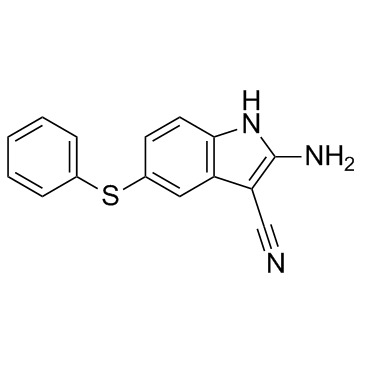91531-98-5
| Name | 2-amino-5-phenylsulfanyl-1H-indole-3-carbonitrile |
|---|---|
| Synonyms |
Ici 134,154
1H-Indole-3-carbonitrile,2-amino-5-(phenylthio) Amphethinile 2-Amino-3-cyano-5-(phenylthio)indole |
| Description | Amphethinile is an anti-tubulin agent. The affinity constant for the association (Ka) of Amphethinile with tubulin is 1.3 μM. |
|---|---|
| Related Catalog | |
| Target |
Ka: 1.3 μM (Tubulin)[1] |
| In Vitro | Amphethinile shows a remarkable similarity to colchicine in terms of its binding to tubulin and inhibition of microtubular assembly. Amphethinile binds strongly to microtubule protein (Ka=1.3 μM). This interaction has been shown to be capable of inhibiting tubulin assembly, but shows no rapid stimulation of disassembly when added to assembled tubulin. The concentration of amphethinile required to inhibit assembly by 50% (12 μM) is very similar to that for colchicine (11 μM). Amphethinile has been shown to be capable of competing for colchicine binding sites but not for those of the vinca alkaloids. Amphethinile can also be shown to stimulate the GTPase activity of tubulin in a manner similar to that observed for combretastatin A4 and 2-methoxy-5-(2',3',4'-trimethoxyphenyl) tropolone (MTPT)[1]. Amphethinile has been shown to cause a G2/M phase block in the cell cycle. In addition, this agent has been shown to be equally toxic toward parental and daunorubicin-resistant P388 cells. Whereas resistance in this cell line is associated with decreased drug accumulation in the case of daunorubicin, vincristine and vinblastine, this effect is much less pronounced for amphethinile[2]. |
| In Vivo | Pharmacokinetic studies in male mice are undertaken. Area under the curve values (AUC), show that levels of 313 μg/L per hour are attained at doses equivalent to the LD10. The alpha half life is 8 min after a bolus intravenous injection. The beta half life is 100 min and relatively independent of dose level[2]. |
| Cell Assay | The volume of methanol in the final incubation mixture is <1%, which does not modify the uptake of any of the drugs used in either drug sensitive or resistant lines. In addition, the same level of methanol is used in the control cultures. Drug incubations (1O μM, 2h, 37°C) are performed in RPMI medium in the presence or absence of horse serum (10%). Cell suspensions (100 mL) are centrifuged (800 g, 10 min, 4°C), washed in PBS, lysed in distilled water by sonication, and the drug extracted into CHC13. The amphethinile concentration is determined spectrophotometrically (λ=304 nm) relative to a standard curve[2]. |
| Animal Admin | Mouse: Initial toxicity studies on this agent are performed under contract in MFI-strain male mice following an acute i.v. and i.p. administration as well as a 4-weekly 5 day sub acute study. Preclinical toxicology is undertaken using the clinically formulated drug. The formulation consisted of 10 g amphethinile and 100 g Solutol HS15 diluted to 200 mL with70% ethanolic citrate buffer at pH 6.0. The resulting drug concentration is 50mg mL[2]. |
| References |
| Molecular Formula | C15H11N3S |
|---|---|
| Molecular Weight | 265.33300 |
| Exact Mass | 265.06700 |
| PSA | 90.90000 |
| LogP | 4.35418 |
